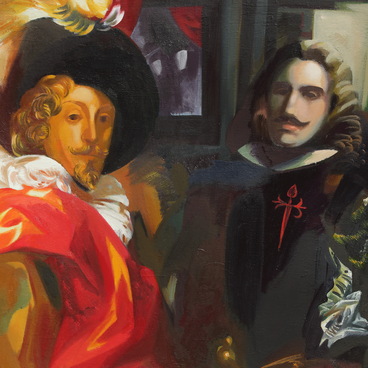Ivan Kirillovich Slyusarev was an outstanding and prolific Ural painter. Throughout his career, the artist created over 2,500 paintings and sketches. Most of them are landscapes reflecting the beauty of the Ural nature. Slyusarev also tried creating architectural and interior compositions, genre scenes, and still lifes. He worked in different techniques and with various materials, including gouache, tempera, oil, watercolor, and etching.
The work “Trackman’s Cabin at Istok Platform” most likely appeared after the artist’s trip to Maly Istok — a small settlement near Yekaterinburg that used to be called Khutory. At the end of the 19th century, the Ural industrialist Ryazanov found gold and established extraction facilities on the settlement’s territory.
The image of Maly Istok in the work of Slyusarev is not accidental: this place is associated with his friend and mentor Leonard Viktorovich Turzhansky, a Moscow painter, student, and follower of the Russian artists Alexei Stepanov, Valentin Serov, and Konstantin Korovin. Leonard Turzhansky adhered to the traditions of the lyrical landscape set by his eminent predecessors. The landscape genre was a prevalent one in his oeuvre. Therefore, even after moving to St. Petersburg in the late 19th century and then relocating to Moscow, Turzhansky returned to his native city of Yekaterinburg to find inspiration in the picturesque Ural nature.
In 1912, Leonard Turzhansky bought a small house in the village of Maly Istok. There he resided and painted from early spring until late autumn. His house became a place of art classes for many landscape painters, including Ivan Slyusarev.
The story behind the acquaintance of Turzhansky and Slyusarev is rather interesting.
Slyusarev had just moved from his native village to Yekaterinburg, where he worked as an assistant clerk in a bakery. Once he was in a market and saw an enthusiastic man, who was in fact Turzhansky, sketching a horse in an album. When the sketch was finished, the two started talking, and Slyusarev told the artist about his passion for art and painting. Turzhansky advised Slyusarev to keep up with his studies and later instructed and supervised him.
Slyusarev’s painting depicts a rural landscape bathed in sunlight. The field road is flanked by rows of small pine trees, and wooden houses can be seen in the background. Although the title mentions the trackman’s cabin, the Ural nature is the true main character of this painting.
The work “Trackman’s Cabin at Istok Platform” most likely appeared after the artist’s trip to Maly Istok — a small settlement near Yekaterinburg that used to be called Khutory. At the end of the 19th century, the Ural industrialist Ryazanov found gold and established extraction facilities on the settlement’s territory.
The image of Maly Istok in the work of Slyusarev is not accidental: this place is associated with his friend and mentor Leonard Viktorovich Turzhansky, a Moscow painter, student, and follower of the Russian artists Alexei Stepanov, Valentin Serov, and Konstantin Korovin. Leonard Turzhansky adhered to the traditions of the lyrical landscape set by his eminent predecessors. The landscape genre was a prevalent one in his oeuvre. Therefore, even after moving to St. Petersburg in the late 19th century and then relocating to Moscow, Turzhansky returned to his native city of Yekaterinburg to find inspiration in the picturesque Ural nature.
In 1912, Leonard Turzhansky bought a small house in the village of Maly Istok. There he resided and painted from early spring until late autumn. His house became a place of art classes for many landscape painters, including Ivan Slyusarev.
The story behind the acquaintance of Turzhansky and Slyusarev is rather interesting.
Slyusarev had just moved from his native village to Yekaterinburg, where he worked as an assistant clerk in a bakery. Once he was in a market and saw an enthusiastic man, who was in fact Turzhansky, sketching a horse in an album. When the sketch was finished, the two started talking, and Slyusarev told the artist about his passion for art and painting. Turzhansky advised Slyusarev to keep up with his studies and later instructed and supervised him.
Slyusarev’s painting depicts a rural landscape bathed in sunlight. The field road is flanked by rows of small pine trees, and wooden houses can be seen in the background. Although the title mentions the trackman’s cabin, the Ural nature is the true main character of this painting.

